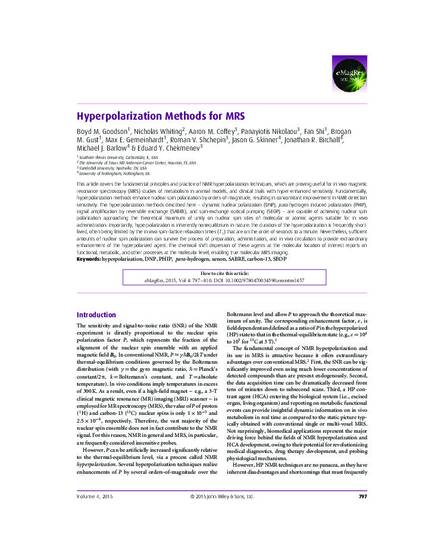
Contribution to Book
Hyperpolarization Methods for MRS
Encyclopedia of Magnetic Resonance (eMagRes)
(2015)
Abstract
This article covers the fundamental principles and practice of NMR hyperpolarization techniques, which are proving useful for in vivo magnetic resonance spectroscopy (MRS) studies of metabolism in animal models, and clinical trials with hyper-enhanced sensitivity. Fundamentally, hyperpolarization methods enhance nuclear spin polarization by orders-of-magnitude, resulting in concomitant improvement in NMR detection sensitivity. The hyperpolarization methods described here – dynamic nuclear polarization (DNP), para-hydrogen induced polarization (PHIP), signal amplification by reversible exchange (SABRE), and spin-exchange optical pumping (SEOP) – are capable of achieving nuclear spin polarization approaching the theoretical maximum of unity on nuclear spin sites of molecular or atomic agents suitable for in vivo administration. Importantly, hyperpolarization is inherently nonequilibrium in nature: the duration of the hyperpolarization is frequently shortlived, often being limited by the in vivo spin–lattice relaxation times (T 1) that are on the order of seconds to a minute. Nevertheless, sufficient amounts of nuclear spin polarization can survive the process of preparation, administration, and in vivo circulation to provide extraordinary enhancement of the hyperpolarized agent. The chemical shift dispersion of these agents at the molecular location of interest reports on functional, metabolic, and other processes at the molecular level, enabling true molecular MRS imaging.
Disciplines
Publication Date
2015
Editor
J. Griffiths and P. Bottomley
Publisher
John Wiley and Sons, Inc.
DOI
10.1002/9780470034590.emrstm1457
Citation Information
Boyd M. Goodson, Nicholas Whiting, Aaron M. Coffey, Panayiotis Nikolaou, et al.. "Hyperpolarization Methods for MRS" Encyclopedia of Magnetic Resonance (eMagRes) Vol. 4 (2015) p. 797 - 810 Available at: http://works.bepress.com/nicholas-whiting/15/
